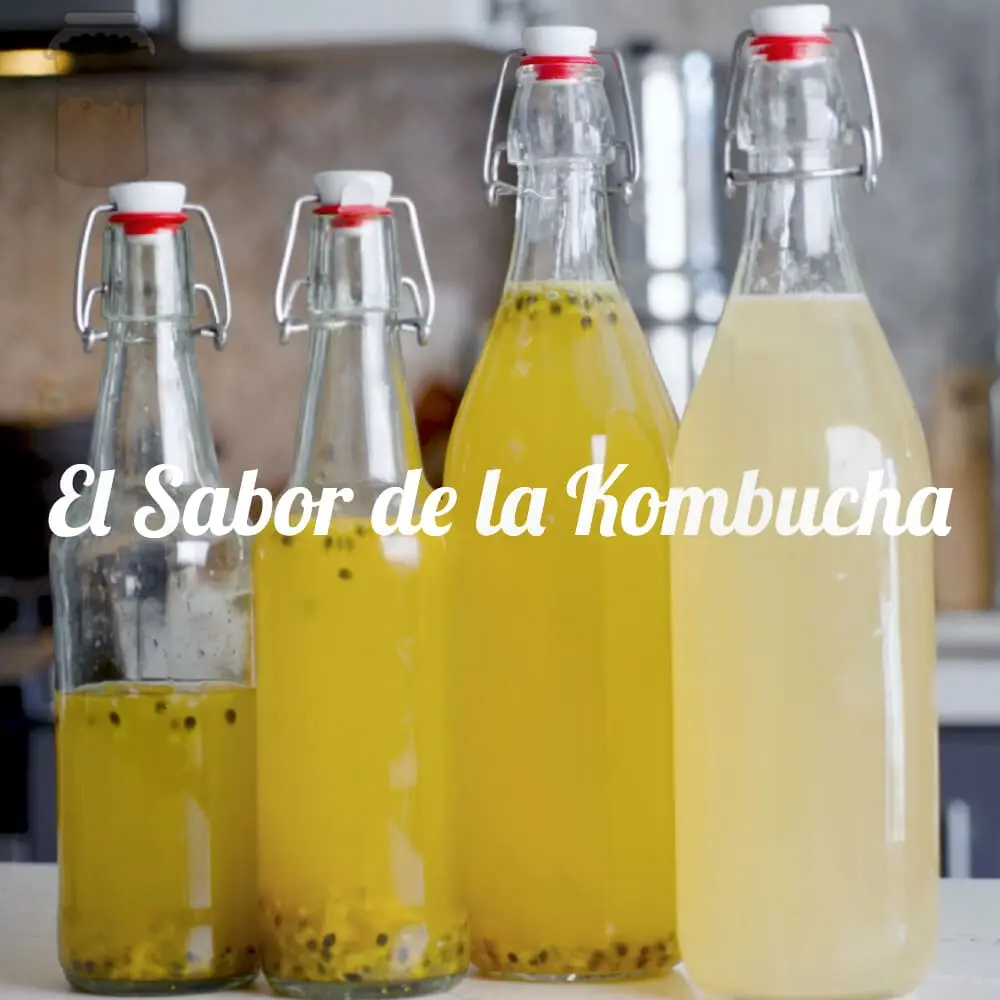The signature refreshing, distinctive, and spicy flavor of kombucha is sometimes not to everyone’s liking, so many people who try kombucha feel like a beginning and an end at once, even when there are all those reports of possible benefits.
To attract more consumers, this drink has been mixed with other natural extracts that help improve flavor while maintaining or enhancing its beneficial qualities for health, resulting in a very attractive drink with a diversity of unique flavors in itself. [1]
What determines the flavor quality of kombucha?
The characteristic taste of kombucha slightly sweet, sour and with fruity essence is determined by the fermentation conditions mediated by yeasts, bacteria, temperature, and time, in addition to the ingredients used. Any change in these aspects can affect both the taste and aroma of the drink. [1] [2]
Fermentation between 6 to 10 days can generate a refreshing drink with a fruity flavor, but if fermentation is prolonged more than 10 days it becomes unpleasant with a strong vinegar flavor, although if temperatures are lower many times after 10 days it may not be ready. Also another aspect to take into account is the ethanol content that if it exceeds 1% can be detected in the flavor and aroma, also generating the characteristic burning of this (see the alcohol content of kombucha here). [1]
That is why at lower temperature or with more sugar they become sweeter, thicker drinks with fruity aromas, at higher temperature it is associated with a fermented, vegetable, yeast flavor with an effervescent, sour, or bitter sensation.
The sensory attributes of kombucha can be modified depending on the tea used, amount of sugar, fruits and vegetables in which they are infused. [1] [2]
Microorganisms to improve taste.
There are several microorganisms that can enrich the kombucha product by improving both its sensory and nutritional qualities.
These microbes give kombucha unique aromatic flavors, the most prominent being Saccharomyces that are used in mixed fermentations where more than one strain of yeast and bacteria is involved. We also have lactic acid bacteria (LAB), which similar to yeasts can improve the taste and nutritional quality of kombucha.
Lactobacilli brevis, in addition to the flavor, also improves its antioxidant capacity. Another aspect to mention is that these microorganisms produce volatile substances which generate a mild flavor and perceptible aroma. Even so, some bacteria such as acetic acid can generate a taste similar to vinegar. [3]
Gluconic acid to improve taste.
Kombucha with a higher amount of gluconic acid has been proven to taste better, while with a higher amount of acetic acid it has a more sour and unpleasant taste.
The drink can present both compounds, but a greater proportion of one with respect to the other generates changes in the palatability of this, more acetic acid gives it a more intense sour flavor being very bitter on the palate and with a pungent smell while gluconic acid has a softer and more refreshing sour taste.
Gluconic acid is what generates the pleasant sour taste of the drink, some microorganisms, such as Starmerella davenportii and Gluconacetobacter intermedius, contribute to favor the production of this acid, improving the sensory quality of the drink. [4]
How does water affect taste?
The water can have a different composition depending on where it is obtained and this can affect the final taste of the kombucha, the most important thing is that it is free of contaminants that can harm the health of the consumer and impair the stability of the SCOBY.
The different water sources available can have their negative impact during kombucha preparation, for example, well water can contain high concentrations of minerals such as bicarbonate, iron and magnesium inhibits bacteria and yeasts that improve the taste of kombucha.
Spring water can also contain a high concentration of minerals and like municipal water, which is commonly used to prepare kombucha, is treated with chlorine, fluoride, and other compounds with the intention of making it fit for consumption.
Although it is the most ideal to prepare kombucha due to its safety, these treatments cause the water to have some antimicrobial effects, which can harm the health of the SCOBY and reduce its ability to ferment thus decreasing the production of metabolites that contribute to flavor and its benefits. [1]
For this reason, the ideal is always to use distilled water, or as filtered as possible.
What flavors you can give to your kombucha
You can add fruit or herbal flavors to your kombucha. Fruit juices are an excellent natural source for flavor and color, although you can also add commercial flavors or colorings. There are kombuchas with only one flavor, but those with mixed flavors are the most popular, having more than one fruity flavor. [5]
The natural extracts that you can use are ginger, lemon, blueberry, raspberry, strawberry, lime, mint and mango, there are quite particular ones such as pitanga and umbu-cajá that generate a fairly sweet drink with fruity aromas. This is one of the advantages of using fruits in kombucha as they contain sugars such as glucose and fructose that give sweetness to the drink and work as food for probiotics. [6]
Another way to flavor is by using commercial flavorings, not artificial but pre-made natural and organic flavor extracts. Most are vanilla, almond, lemon, and orange, after preparing the kombucha you can bottle by adding 1/8 tablespoon of the flavoring of your choice for each glass of kombucha and store in refrigerator.
Is it good to use cinnamon in kombucha?
Cinnamon has proven to be the best option to prepare flavored kombucha, not only improves the healthy properties of the drink is also who gives a more pleasant sensation to the palate compared to other ingredients used to improve its flavor.
Cinnamon is considered the best medicinal plant to improve the flavor of kombucha, in several studies it obtained very high scores regarding flavor, aroma, acidity, sweetness and color, being more delicious compared to other samples. Therefore, kombucha drinks prepared with cinnamon would gain greater acceptance by consumers.
Also, cinnamon has a high antioxidant power that improves this characteristic of kombucha by offering compounds such as cinnamic acid, eugenol and coumarin. [7]
Can you improve your taste with ginger?
Yes, the fresh ginger grated or peeled and cut into slices can be added in the kombucha broth after the first fermentation, for each cup of kombucha you can use 1/2 teaspoon of grated ginger or chopped pieces (with a 7-centimeter ginger) and mix until this even.
Something interesting is to combine it with other ingredients to diversify the flavor of kombucha, they can be fruit juices either apples or oranges, although you can also use honey to give it a sweet and spicy touch. You can do this on a gallon of fermented kombucha and start a second fermentation with these ingredients.
Leave in a cool and dark place for 3 to 7 days watching how the fermentation goes, if you notice after 3 days that this bubbly should pass it to a refrigerator, the flavor will be defined after a week, you must stop fermentation when that time passes.
What fruits can I use in my kombucha?
They can be fresh, frozen, dried, canned fruits or use their juice to add them to the drink, the sugar of these feeds the yeasts and bacteria in the drink improving not only the flavor, but also helps in the carbonation process of this during the second fermentation.
Some of these juices or whole fruits, apart from those already mentioned, can include cherries, blackberries, blueberries, grapes, peach, grapefruit, berries, and pineapple, as for dried fruits has dates, elderberries, figs, goji berries, Inca berries and raisins.
You can use a blender to crush them until they are soft and distribute them evenly in the drink. [8]
Fresh fruit can also be added whole as long as the juice is not extracted, although if you also squeeze the juice to use it in the drink it is a good idea to include the fruit already squeezed to further intensify the flavors and aromas. [9]
In my particular case, I usually add strawberries or grapes when I want to flavor it, or I use honey in its preparation, although in most cases I consume it naturally because I love it that way.
Keep in mind that adding fruits to it will increase the gas, and thus the risk of explosion so you should be careful. Therefore, you can review the post on how to gasify kombucha, and the main kombucha containers.
Does the type of tea used have an impact on taste?
The teas or herbs used in kombucha can slightly change the final composition of this and therefore the flavor, depending on the tea you use there may be a slight or drastic difference between flavors from one kombucha to another, in addition you can modify the effects it can have on the health of either the scoby or the body.
The types of herbs that can be used are chrysanthemum, honeysuckle, and mint, giving them menthol and refreshing flavors. Using them together with tea to ferment kombucha can allow us a great diversity of flavors, it can reduce the tea you are going to use by half. If you are going to use roots or bark, you should use them grated in the same amount of tea. [10]
How can you prepare flavored kombucha?
The ingredients that will give flavor to our kombucha should be added before the final fermentation, you can use the juices, preserves, puree, jams, or fruits whether fresh, frozen, or canned, whatever you like best and bottle while watching the fermentation. [8]
Kombucha with previously boiled tea, scoby is added and left to ferment at room temperature, dried or processed fruits or any other commercially processed ingredient is added to improve the flavor. You can also flavor using fresh fruit juices or unpasteurized juices, and you can include whole fruit already squeezed. [9]
When bottling your fermented kombucha and before adding the flavors, you should leave a top space of 2 or 5 centimeters, then cap the bottle and let it ferment for 1 to 7 days by opening the lid once a day to release the fermentation gases (CO2) decreasing the internal pressure.
When the days go by, check that it has the desired flavor and an effervescent sensation, so it will be ready to refrigerate and consume. [8]
More content!

